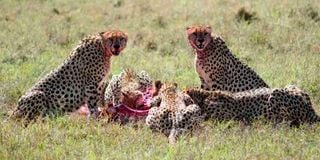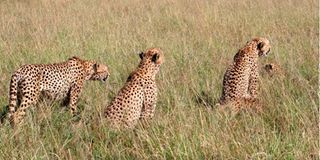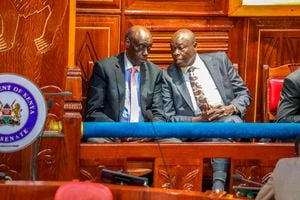
India’s Prime Minister Narendra Modi looking at a cheetah at the Kuno National Park in Madhya Pradesh, India, on September 22, 2022. Eight cheetahs had arrived from Namibia five days earlier.
| Courtesy | AFPNews
Premium
India’s obsession with cheetahs and Kenya’s new role in it
What you need to know:
- The resurgence of interest came to light during Kenyan President William Ruto's state visit to India.
- India’s cheetah population went extinct around 70 years ago.
- India got eight cheetahs from Malawi last year as it hopes to re-establish the big cat’s existence in the country.
India’s long-standing fascination with cheetahs has taken a prominent turn as the nation seeks to reintroduce this majestic species into its landscape.
The recent development, in which Kenya is involved, marks a significant chapter in India’s relentless pursuit of re-establishing a cheetah population, which had vanished from its territory over 70 years ago.
The resurgence of interest came to light during the State visit of Kenyan President William Samoei Ruto, when India expressed a keen desire to procure more cheetahs from Kenya.
This proposal, initiated by India’s Environment ministry, is part of the Asian country’s bid to rejuvenate its ecological heritage.
“In Kenya, the population of cheetahs is estimated at 1,160 individuals and listed as endangered species in the Wildlife Conservation and Management Act 2013!” Kenya Wildlife Service (KWS) said in a post on X last week. “These magnificent creatures face serious threats such as habitat loss, human-wildlife conflict and poaching which put their survival at risk, emphasising the crucial need for conservation efforts to secure their future posterity.”
KWS and the government have not released specifics on the number of cheetahs to be sent to India. Neither has there been a disclosure on when and what kind of arrangements it has made with India.
Currently, Kuno National Park in central India harbours 15 surviving cheetahs, marking a pivotal location for the species’ revival in the country
The bilateral discussions between India and Kenya during the visit resulted in the signing of several memoranda of understanding, spanning sectors like agriculture, healthcare, and more.
It underscored Kenya’s decision to join global alliances focused on biofuels, big cats, and solar energy.
Indian Prime Minister Narendra Modi lauded Kenya’s inclusion in global alliances, emphasising how collective efforts would fortify the conservation of big cats worldwide.

Members of the famous cheetah coalition, nicknamed ‘Tano Bora’, at the Maasai Mara Game Reserve in November 2020.
This new-found collaboration between the two nations extends beyond environmental endeavours, encompassing crucial areas like maritime security, healthcare, education, and counter-terrorism initiatives.
Also Read: In cheetah’s eyes, you will see, ‘help me’
Said Mr Modi: “I am glad that Kenya has decided to join the Global Biofuels Alliance, Big Cat Alliance, and International Solar Alliance. We will be able to strengthen global efforts for the conservation of big cats.”
From Namibia
India’s fervour for reintroducing cheetahs stems from a historical void left after their extinction in 1952, attributed to human interventions and hunting practices during colonial times.
Last September, eight radio-collared cheetahs made a 5,000-mile journey from Namibia to India, eventually landing at Kuno National Park.
Their arrival marked the final phase of a 13-year-long effort called Project Cheetah that aims at reintroducing the big cat species to India’s grasslands 70 years after they were hunted into oblivion.
The project’s launch also coincided with the 72nd birthday of Mr Modi, who celebrated by personally releasing the first cat from its crate into the park.
“Decades ago, the age-old link of biodiversity that was broken and became extinct, today we have a chance to restore it, ” Mr Modi said then. “Today, the cheetah has returned to the soil of India.”

The five male cheetahs known as Tano Bora or the Five Musketeers at the Maasai Mara game reserve on June 24, 2020.
However, the journey to restore the cheetahs has faced substantial challenges and setbacks as the fate of the high-profile conservation project hangs in balance after nine out of 20 cheetahs, including three cubs, have died of various causes since March.
These setbacks, attributed to various causes including health complications and management issues, have prompted increased vigilance and scrutiny.
Authorities have recaptured the remaining cats and kept them in enclosures for close monitoring and supervision, where they will continue to remain until a government-appointed committee of wildlife experts approves their re-release into the wild.
But why does India want to reintroduce cheetahs?
“India’s motivation stems from the desire to restore a vital element of its ecological heritage,” SP Yadav, who leads Project Cheetah on behalf of the Indian Environment ministry’s forestry department shared in an interview with Time. “By bringing them back, India aims to showcase its commitment to conservation and biodiversity restoration.”
During the cheetahs’ release last September, Mr Modi told spectators that “along with these cheetahs, the nature-loving consciousness of India has also awakened with full force”.
India’s pursuit of reintroducing cheetahs into its ecosystem , analysts say, serves as a beacon of hope for global conservation endeavours.





